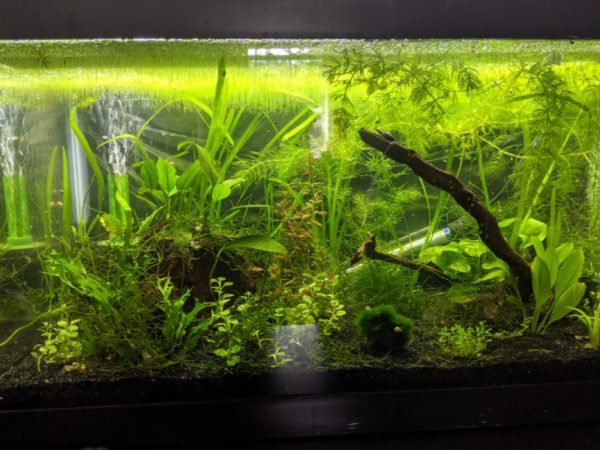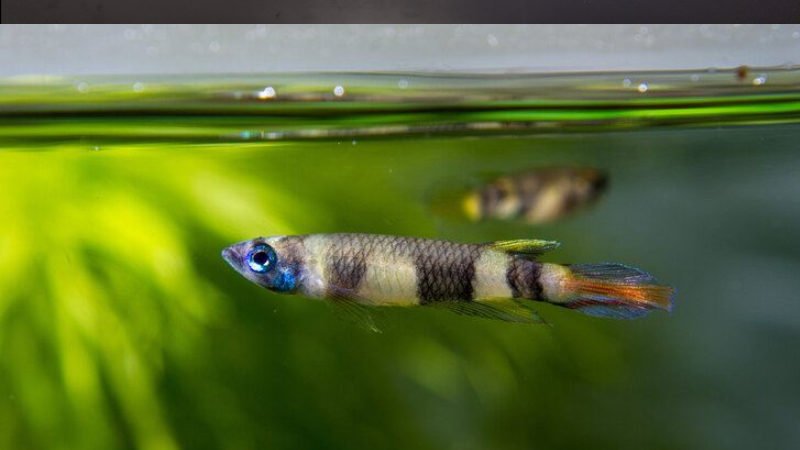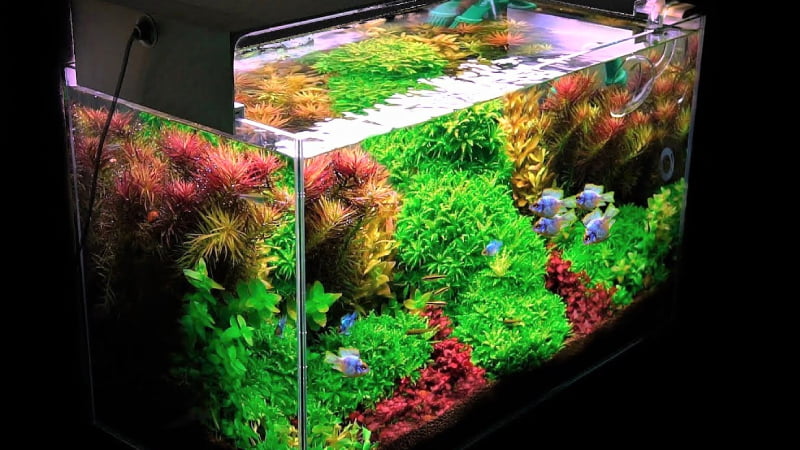Killifish is a beautiful freshwater fish that is vibrantly colored and beautifully patterned. It seems that there are a lot of patterns and colors available, and they’re all gorgeous! Also, they get along well with their tankmates, and they are pretty easy to care for.
They are therefore a popular choice for many freshwater aquarists. Seeing that they are so popular, we wanted to create a killifish aquarium setup guide that would help owners, both new and experienced, find the essential information. When you have finished reading this guide, you can provide your fish with the best conditions to live happily.
Killifish Aquarium Setup
In this section, you’ll learn more about the conditions and what you should set up in your killifish tank. You should read this advice alongside the advice specific to your species.
Since killifish inhabit a vast range of different environments in the wild, as well as most of them being quite hardy, mimicking their natural surroundings in a tank setting isn’t that difficult.
In order to determine the size of the tank and setup you will need, you will have to know how many fish you would like to keep and why you want to keep them.
Depending on the species of your killifish, you will also need to decide whether the tank should be saltwater or freshwater.
Tank Setup
When it comes to a regular pair of killifish, a 20-gallon tank is perfect; if you are going with one of the larger species, adjust the size of the tank accordingly.
It is recommended that most killifish should be kept in a long, shallow tank with minimal to no water movement. It is advisable to keep plants in your tank, especially floating ones. The cryptocorynes are the perfect plant for this situation. Because of the fact that they are very tolerant of low levels of light, they are perfect for it.

The tank can be left bare on the floor, but most people prefer to cover it in dark gravel. If you decide to use gravel, you will need to choose one that will not harden the water.
In the event that you intend to get bottom spawners, you should avoid using gravel, but you can use peat (as long as there aren’t any fertilizers or additives in it).
It is also important to provide some hiding places for your killifish. These hiding places can appear in the root systems of floating plants, rocks, or wood.
In dealing with Killifish, it is advisable to be aware that these lightweight species of fish are excellent jumpers when they are in the wild. Keep these frisky fish safely contained by installing a solid lid, as well as being careful when cleaning or otherwise maintaining your aquarium.
Tank Conditions
Your tank’s water conditions will entirely depend on the type of killifish you plan to keep there.
Killifish generally prefer water temperatures of between 72 and 75 degrees Fahrenheit. You can use a regular aquarium heater if you only have a single tank. However, serious keepers, who tend to have a room full of tanks, may choose to heat the entire room instead.
Because each Killie has a different preference in terms of pH balance, the pH balances are different in each Killifish tank. Some species of fish live in soft acidic waters, while other species live in hard alkaline waters.
The water hardness for most killifish should be between 120 and 160 ppm. You can be flexible when setting the water hardness. It does not need to be completely right as the pH balance. However, you have to note that some species only thrive in soft water or hard water.
Depending on the species of fish you have, the lighting will also differ. In general, killifish are used to shading from direct sunlight and therefore prefer low-light tanks.
In general, killifish dislike water currents that are too strong or that move too rapidly, they prefer little or no movement of the water.
As for filtration, if you have a small tank, it may accumulate waste quickly, so you need to use a filter. But the filter can cause strong currents. To avoid it, you can do small, frequent water changes regularly instead.
Toxins will be removed by a filter, and in a small tank, the most common type of filter to use is a simple box filter with filter sponges or filter wool.
The Best Tank Mates For Killifish
Killifish are found across a wide range of geographic regions. Any other fish that lives in these conditions could therefore be regarded as having the potential to make a good tank mate.

As the killifish occupy the top half of the tank, it would be best to keep them with other peaceful species that are bottom-dwelling fish. They will never infringe upon each other’s territory and do not show aggression. There are two common bottom-dwelling species of fish: the Corydoras and the Kuhli loaches.
There are also a few good tank mates that you might like: Tetras, Rasboras, and livebearers of a similar size.
You should always avoid any species that have a similar appearance to the male version of the killifish. As well as that, make sure to avoid larger and more aggressive fish such as angelfish and barbs. These larger fish should be avoided because they will only cause stress to your fish.
In addition, smaller fish (like fry) should also be avoided since they will be considered prey.
Invertebrates like shrimp and snails also should be avoided if you don’t want them to be an expensive and tasty snack for killifish.
You should keep in mind that all tank mates should be able to live in soft, acidic waters with low light. Additionally, when feeding your fish, make sure they don’t compete for food with each other.
Video About Killifish Aquarium Setup
FAQs
Do killifish need an air pump?
No, killifish do not require an air pump as they are a hardy species.
How big of a tank do a killifish need?
The small size of killifish makes them perfect for nano and desktop aquariums. A trio of species can be housed in a tank of five to ten gallons in species tanks. For community setups or if you intend to keep more than one male, you should consider keeping an aquarium of 20 gallons or larger.
How many killifish can fit comfortably in a 5-gallon tank?
In a 5-gallon aquarium, you can house two Killifish, since they each require at least 2 gallons of space. But when it comes to male killifish, only keep one male in the tank because they can show aggression towards other males if kept together.
Conclusion
Killifish are some of the most stunning fish around and deserve more attention in the fishkeeping hobby. They are a great choice for any fish keeper, regardless of their experience level.
To make Killifish live healthy, happy, and increasingly beautiful, it requires you to take care of them properly, especially having an appropriate killifish aquarium setup.

Annette M. Chaney is an experienced marine biologist with over 20 years of experience as an aquarist and fishkeeper. She started her first aquarium at a young age, filling it with frogs and goldfish obtained from the ten-cent pet store.
Annette grew up caring for and breeding African Cichlids, which led to a hobby in high school that doubled as a profitable means. Attending Reed College gave her time to solidify herself as an accomplished aquarium caretaker with an eye for sales. After that, from 2009 – 2013, she studied at Roger Williams University – one of the most prestigious universities for Aquaculture and Aquarium in USA. She is the founder of AquariumCircle since 2010.
